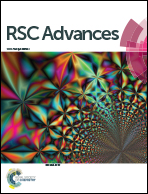Interface and core relaxation dynamics of IL molecules in nanopores of ordered mesoporous MCM-41: a dielectric spectroscopy study
Abstract
The dynamics of ionic liquid (IL) 1-ethyl-3-methyl imidazolium tetrafluoroborate ([EMIM][BF4]) molecules confined in ordered porous MCM-41 (Mobil Composition of Matter no. 41) with an average pore diameter d = 3.4 nm has been investigated by dielectric measurements. The appearance of a peak in the loss tangent suggests the presence of relaxation in the IL confined ordered mesoporous matrices from which two types of confined states of IL were found; pore wall surface adsorbed IL and core of pore filled IL. The dielectric measurements in the frequency range 1–10 MHz and temperature range 40–100 °C showed that the dynamics of surface adsorbed IL gets slowed down compared to the IL molecules in the core of the pore. The slowest molecular motions of surface-adsorbed ionic liquid results from strong interaction between ionic liquid molecules and the pore wall surface due to which the activation energy is different from the activation energy of bulk IL molecules. Also, Electrode Polarization (EP) phenomenon exists in all the samples and the corresponding peak is shifted towards a higher frequency region as temperature or amount of IL increases. The variation of ac conductivity with frequency obeys Jonscher power law. The dc conductivity increases with increase the IL loading.


 Please wait while we load your content...
Please wait while we load your content...